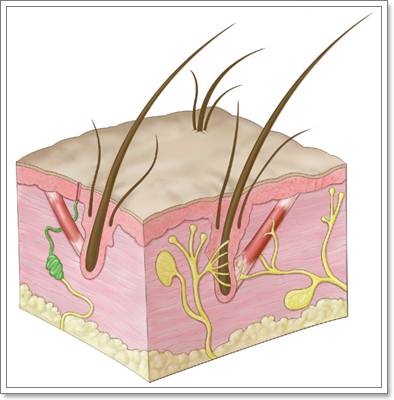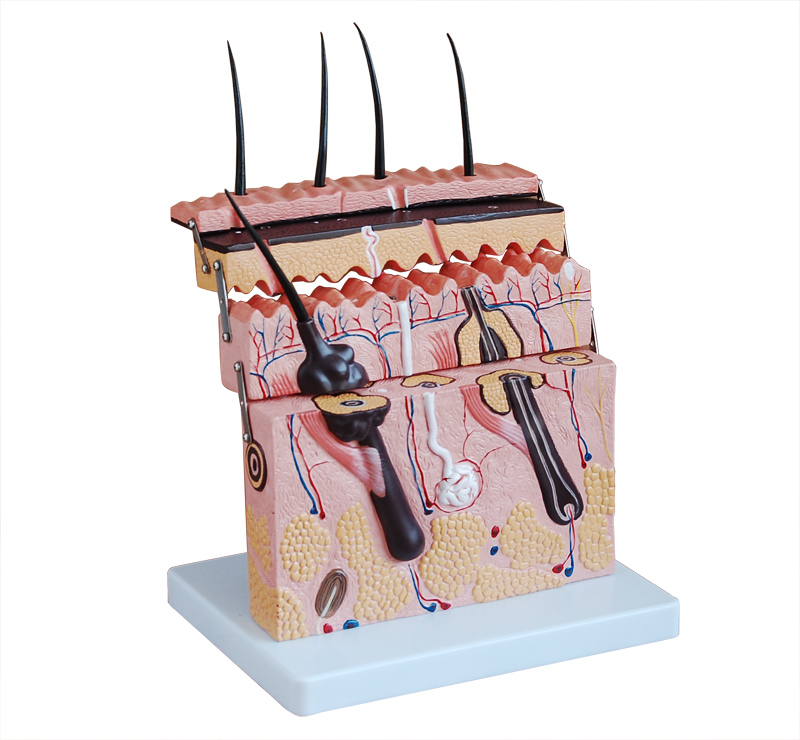Skin layer

hair
Every human being has 85,000 to 150,000 hairs. The blonde hairs have the most hairs. While people with red hair have the least number of hairs. Each feather is about 0.08 millimeters in length and 0.1 to 0.2 millimeters long in length. Included are 30 meters of fur and 6 square centimeters of hairs. 90 percent of hair is keratin. And it will pop up from the roots in the pores in the 2 to 6 years. The hair roots will create new substances to continue to produce 80 cm long hair. Then there is a two-week rest period before the roots begin to form new hairs, which push the pre-existing hairs to the skin until they fall off.
Stratum corneum
Thick about 0.02 millimeters, corneocytes and fatty substances in the middle. (intercellular lipid) This skin is the top layer of skin that is only 0.02 millimeters thick, which prevents loss of water. (dehydration) and irritants. Allergens And pathogenic microorganisms.
Dermis
Flexible connective tissue about 1 millimeter thick, consisting of vascular system. Sensory organs and nerves, pores, sebaceous glands and sweat glands are all part of the epidermis and have roots in the epidermis.
Flexibility is due to strong collagen. Flexible fibers Plus the basic molecules are very moist. (glycosaminoglycans) exist. These three components are made up of fibroblasts, which change in appearance. Caused by aging (wrinkles, sagging skin, not bright), resulting from the tear and adhesion of the fibers. Including the loss of the foundation's ability to absorb moisture.
sweat glands
These sweat glands produce 98% water-derived secretions, combined with metabolites and salts, which help cool the skin by evaporation. It is important to regulate body temperature. The sweat that just left the body will have a neutral odor.But it becomes an unpleasant odor when combined with bacteria on the skin. Glandular secretions (apocrine sweat glands), which can be found in some parts of the body, contribute to odor. Sweat has a mild acidity. And as part of the film hydrolysis, which is a major component of mild acidity. The skin acts as a natural defenses to protect the skin.
Sebaceous glands
Fat layer (up to 10 cm thick)These glands produce sebum which protects and smoothes the skin and hair. The process is controlled by hormones (androgens). The substance is pH neutral and is part of the acidic pH. The skin that acts as a protective body skin to protect the skin naturally.
All skinIt covers the organs of the body with a maximum thickness of up to 10 cm. The body has been and is not. To burn fat is stored in the form of fat in the fat layer. And it will be used when the body needs it. This stored fat acts to absorb shock and insulate to control.
Body temperature
• Have a sensory sensation.
• 5 hairs
• Cold sensation of about 12 nerve endings.
• There are about 15 glands of sebaceous glands.
• There are about 100 glands of sweat glands.
• Have a vein of about 100 meters.
• Have sensory sensation of about 200 nerves.
• Nervous about 400 centimeters
• There are about 5,000 senses sensory tip.
• There are about 6 million cells.Per square meter
• weight 10 - 20 kg• 0.1 to 10 centimeters• Area of 1.5 - 2 square meters.
Comment
Date: Sun Apr 20 00:09:24 ICT 2025














